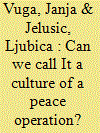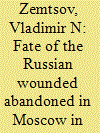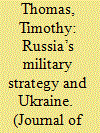|
|
|
Sort Order |
|
|
|
Items / Page
|
|
|
|
|
|
|
| Srl | Item |
| 1 |
ID:
140768


|
|
|
|
|
| Summary/Abstract |
The following article does not discuss various aspects of international cooperation on the political and strategic levels but considers the challenge of cross-cultural cooperation among service members in the field. Cooperation in a culturally diverse environment is influenced by various cultures and identifications (the national culture, military organizational culture, social identities). Based on the presumption that the culture is manifested through the values, rituals, symbols, practices, and language, the thesis about the existence of peace operations’ culture was tested. The main research questions were: (a) how are national and military cultures manifested in a peace operation?; (b) does the culture of a peace operation exist?; and (c) do service members of various nationalities identify themselves with a peace operation? The study was conducted among Italian and Slovenian service members deployed to at least one peace operation. The results show that a peace operation develops practices, values, symbols, rituals, and a common language. Hence we can speak of a peace operation’s culture. The service members’ identification with the peace operation is strong during the deployment; however, sources of identification vary depending on one’s position in the peace operation (i.e., national unit, multi-national HQ). Service members in HQs develop a strong sense of belonging to the multi-national working team, while the main source of common identity for bigger national units is the local environment.
|
|
|
|
|
|
|
|
|
|
|
|
|
|
|
|
| 2 |
ID:
140767


|
|
|
|
|
| Summary/Abstract |
The role of small states in international relations, aspiring to enter into international society as a credible actor, is often measured through their contribution to international security. Slovenia, as a small state, has presumed its ‘well-deserved place’ in the international community could be reached by becoming a trustworthy member of NATO. Among other things, this has meant aligning state policies with those of the political-military organization and so becoming a ‘like-minded’ member of the prestigious club. One of the steps Slovenia has done in this regard was the deployment of its civilian experts to the NATO-led missions to Kosovo and Afghanistan; they were integrated into the contingents of the Slovenian Armed Forces. With this, Slovenian civil-military cooperation in conflict and post-conflict areas has begun, following NATO’s request to contribute not only armed forces but also civilian experts. This article analyzes the development of civil-military cooperation in Slovenia and explores how has it evolved from relatively poorly planned and unorganized attempts to a more structured and better coordinated ‘business’ of a small state in fragile societies. The relationship between the Slovenian military and Slovenian civilian experts from the perspective of ‘being forced to work together’ within the stabilization efforts in Kosovo and Afghanistan is the main focus of this article. The article’s findings, built on interviewing and surveying of Slovenian military commanders and civilian experts, are relevant for a better understanding of small states’ behavior in international relations and military sociology in conflict and post-conflict zones.
|
|
|
|
|
|
|
|
|
|
|
|
|
|
|
|
| 3 |
ID:
140769


|
|
|
|
|
| Summary/Abstract |
The article is devoted to one of the most tragic episodes of the Patriotic War of 1812 (Napoleon’s Russian campaign), associated with a massive loss of Russian wounded in Moscow. For 200 years the participants of the events and historians have expressed many opinions about the causes, culprits of the tragedy, and the number of victims. Based on the integrated use of currently available sources, bringing previously unknown documents from the Russian and French archives, the author has tried to give convincing answers to the key questions of the theme. In his opinion, the retreating Russian army left in Moscow from 10,000 to 15,000 sick and wounded soldiers, of which at least 8,000 died or were taken prisoner. Some of the dead (about 1,000 people) were victims of fire, initiated by Moscow authorities headed by Governor-General F. V. Rostopchin. Causes of death for the greater part of the wounded and sick were associated mainly with the lack of medical care and food.
|
|
|
|
|
|
|
|
|
|
|
|
|
|
|
|
| 4 |
ID:
140770


|
|
|
|
|
| Summary/Abstract |
The aim of this article is to analyze the operations in Western Serbia and the neighboring regions conducted from March through September 1944 by the Yugoslav Partisans on one side and the Germans and collaborationist troops on the other. Knowledge of these operations is important for understanding subsequent military and political developments, namely the joint Soviet-Partisan offensive on Belgrade and the establishment of the Communist-dominated government in Yugoslavia. Little is known about these events in the West, in particular the details of the military co-operation between the Germans and the Serbian Chetniks, which developed to its full extent during this period. By relying on a wide array of primary sources, the article will hopefully shed some light on these complex issues, as well as help settle the still-existing controversies surrounding the Serbian nationalist guerrillas’ role in the last year of the war.
|
|
|
|
|
|
|
|
|
|
|
|
|
|
|
|
| 5 |
ID:
140766


|
|
|
|
|
| Summary/Abstract |
This article details the development of Russia’s military strategy and how elements of that strategy may have been applied in Ukraine. It examines both traditional and contemporary elements of strategy, with a particular focus on the effect of Russian President Vladimir Putin’s competitive logic and the General Staff’s reliance on non-military methods of thought. With regard to the latter, General of the Army Valeriy Gerasimov, Chief of the Russian General Staff, noted that today, non-military measures in operations are used over military operations by a ratio of 4:1. Also examined is the concept of reflexive control, which may have been used as a propaganda method during the Ukraine intervention to exert an information-psychological influence on both Russia’s domestic and international audiences.
|
|
|
|
|
|
|
|
|
|
|
|
|
|
|
|
| 6 |
ID:
140771


|
|
|
|
|
| Summary/Abstract |
The officer corps of the Manchukuo Army was formed on a multinational basis in accordance with the fundamental state principle of the “common home” for the five Nations of Manchukuo. The formation of the Russian officer corps in the Manchukuo Army started with the organization of the Asano detachment in 1938. The Japanese commanders relied on émigré youth, not the Russian Imperial Army’s officers. The nucleus of the Russian officer corps was émigré activists of anti-Bolshevik organizations who considered the Asano detachment the basis of a “White Army.” However, the leadership of émigré units was in the hands of the Japanese secret services, and the training of Russian regulars was based on the ideas of Bushido. Despite all efforts of the Japanese commanders, Russian officers did not meet their expectations in the fight against the Soviet Army in August 1945.
|
|
|
|
|
|
|
|
|
|
|
|
|
|
|
|
|
|
|
|
|